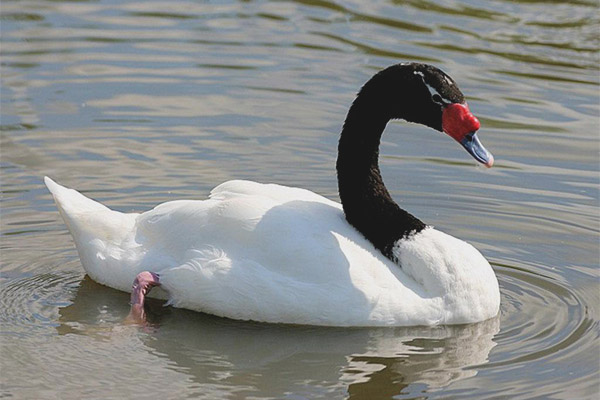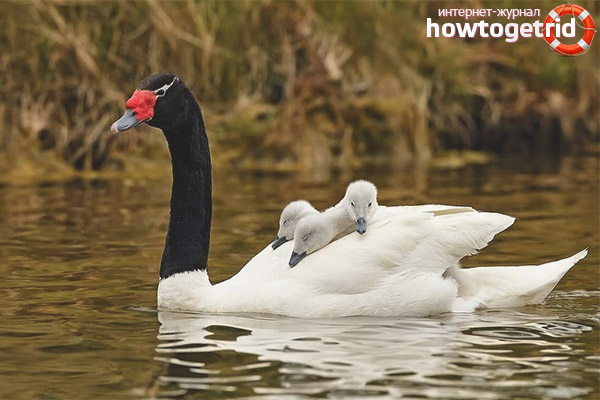The content of the article
Swans stand out among all other members of the feathered family, and this is not surprising. Birds attract with their elegant appearance, tranquility and sophistication in everything. Today we are considering one of the representatives, namely the black-necked swan.
Spread
Most often such birds are found in Brazil, Mexico, Argentina and other parts of South America. Individuals live in the inner section of the Neotropical region. They are also found in Patagonia. These birds may not fly away for wintering if the temperature regime in their habitat does not fall below a certain level.
As for specific habitats, birds are found in shallow water, as well as near the coast of the Pacific Ocean. Individuals prefer marshlands, flat areas, lagoons, inland lakes, estuaries, etc.They are not indifferent to the vegetation of the floating species.
Description
- Individuals of this breed group belong to the family of geese. Along the length of the body, birds grow to 125 cm. At the same time, their body weight ranges from 4 to 7 kg. Females are slightly smaller, their weight hardly reaches 4.5 kg. It is precisely due to these characteristics that the birds are referred to as large-sized ones.
- It is impossible not to touch on the wingspan, since all the birds during the study are subject to the evaluation of these indicators. So, for example, in the female gender, the wings are 40 cm wide, in the male birds - 45 cm.
- Since the previously mentioned that the swans have a characteristic feature, we will touch it. Birds have a black neck, the plumage of the rest of the body is white and pure. The head is also black, the bluish beak with a gray tint, stands out against the background of red skin under the eyes. It looks generally impressive.
- Thanks to this variation of color, the black-necked swan is distinguished from other members of the family. In some cases, the neck and head may have blotches of a different color.
- Behind the eyes there is a strip of whitish tone. She reaches the neck, her back. The wings of these birds are sharp, white. The legs are pinkish, short, look disproportionate due to a certain length and angle of inclination. These birds walk little, because these actions are given to them with difficulty.
- Juveniles do not have such a bright and characteristic plumage for adults. It has brownish feathers, after several molts and upon reaching puberty the young birds will achieve the desired characteristics. The whitish body and the characteristic dark neck are acquired after a year of life.
Breeding
- The represented individuals belong to the monogamous, they find a constant pair for themselves and give birth to offspring. If the half dies, then the second swan finds another companion. As for the mating season, it lasts from mid-summer to mid-autumn.
- Males at this time are very aggressive. They attack rivals, suppressing the desire to take a female. Then they return to their half and begin a full-scale operation to seduce. Males exhibit plumage and habits.
- When a couple is formed, the individuals begin their mating dance.First, they immerse their heads in the water space, then they pull the necks out strongly and start spinning in the dance. Then after a while they set off to build a dwelling for the future offspring, choosing thick vegetation near the reservoirs.
- The male is engaged in collecting material for the nest, and the female puts everything. The house is half submerged. Down is used as a litter. The future father carefully guards the eggs without leaving the nest.
- Hatching out by the female is carried out for 35 days. Each egg weighs about 200 grams. Juveniles begin to fly in 2.5 months, but do not move far away from their parents during the first 3 months.
- When the young grow up, it remains to live in the family, occasionally flying away. By three years, a new couple is being formed, which, by analogy with the previous one, builds a dwelling and continues the race.
- Newly-minded parents roll their babies on their backs, but, as a rule, the father of the family does this. The female is responsible for feeding and rearing. She also needs to gain weight, which is gone during the vidicke. The offspring is monitored, protecting it from predators.
- These birds carefully protect the laid eggs or the offspring born from predators.But the swans are powerless against humans; usually when people appear, they quickly leave the nest and leave the eggs without covering them.
Characteristics
- Black-necked swans belong to those individuals that breed regardless of the season. It should be noted separately that during the mating season, such birds become territorial and a little aggressive. During this period, swans are trying to hide in dense vegetation and reeds.
- During the breeding season, such individuals are often kept in pairs or small families. After nesting, they again regroup into large flocks, which number over a thousand individuals. Such groups can constantly fly depending on the climate and the abundance of food. Often birds adhere to the southern regions.
- The individuals in question are mostly in the water. Due to the fact that their feet are placed in a special way, it is inconvenient for them to move by land. They move awkwardly and funny. Therefore, their paws are designed exclusively for swimming. If such birds notice danger, they quickly fly over long distances.
- Often, in places where they met with danger, the swans no longer return. The considered individuals belong to the fastest representatives of the flyers among the relatives. Such swans are capable of reaching speeds in flight of up to 85 km / h.
Nutrition
- The basis of food of such birds often includes food of plant origin. They get food at the bottom of reservoirs. These swans have a strong beak with teeth on the end. In addition, there is a large number of bristle bristles on the tongue. It is with the help of it that the swans tear down the leaves of the plants.
- In addition, the cloves, which are located in the beak, help individuals to filter the small food that they get from the water surface.
- Black swans can be attributed to vegetarians, they often feed on wild celery, vegetables, yarrow and similar aquatic plants. In rare cases, the individuals in question may eat frog eggs, fish, and small invertebrates.
Interesting Facts
- As for the number of these birds, it is stable. The species in question is widely distributed in many countries of the world.In addition, swans have an extensive habitat. In the aggregate, if you add up all the reasons, we can say that such birds are practically not endangered.
- Despite all this, the bird hunt continues. People shoot swans for warm down. This material is used in the manufacture of bed linen and winter clothing.
As the name implies, the swan has a distinctive feature in the form of a black neck. Such birds are found in artificially created reservoirs and gardens, since they can be watched for a very long time.
Video: Black-necked Swan (Cygnus melancoryphus)













To send